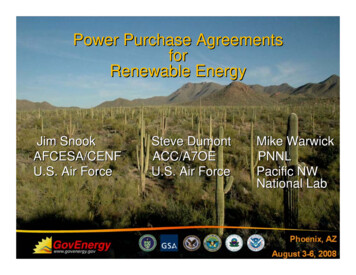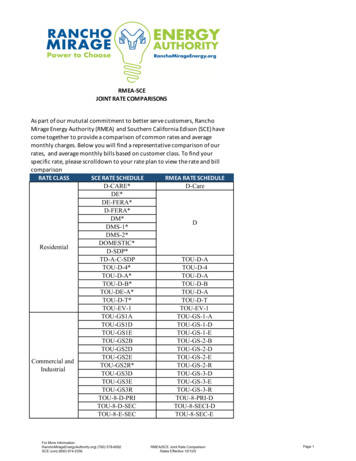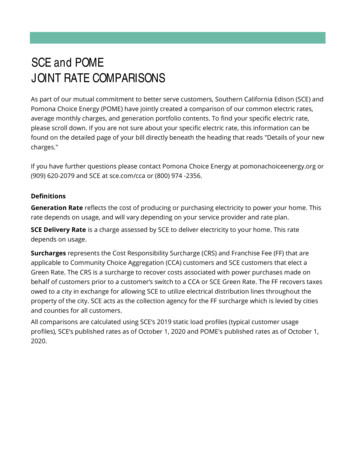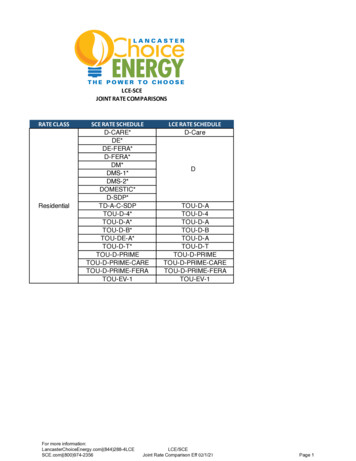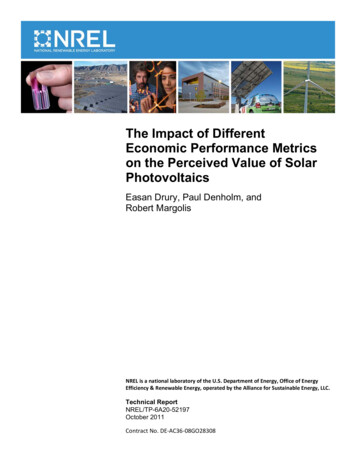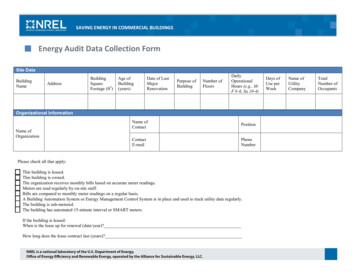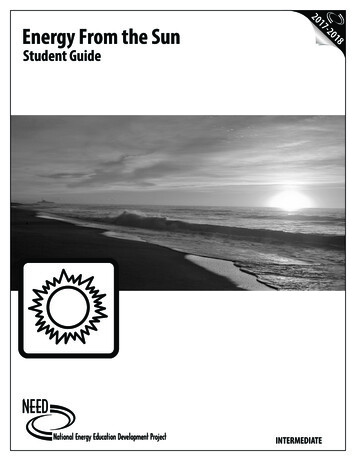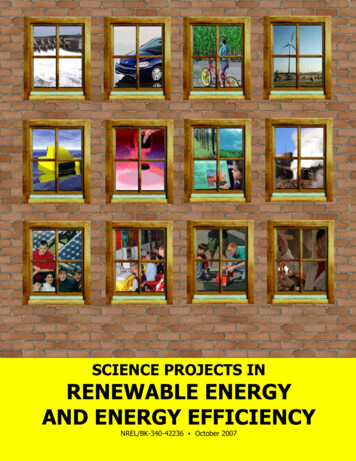
Transcription
SCIENCE PROJECTS INRENEWABLE ENERGYAND ENERGY EFFICIENCYNREL/BK-340-42236 C October 2007i
Some of the educational lesson plans presented here contain linksto other resources, including suggestions as to where to purchase materials.These links, product descriptions, and prices may change over time.NOTICEThis report was prepared as an account of work sponsored by an agency of the United Statesgovernment. Neither the United States government nor any agency thereof, nor any of their employees,makes any warranty, express or implied, or assumes any legal liability or responsibility for the accuracy,completeness, or usefulness of any information, apparatus, product, or process disclosed, or representsthat its use would not infringe privately owned rights. Reference herein to any specific commercialproduct, process, or service by trade name, trademark, manufacturer, or otherwise does not necessarilyconstitute or imply its endorsement, recommendation, or favoring by the United States government or anyagency thereof. The views and opinions of authors expressed herein do not necessarily state or reflectthose of the United States government or any agency thereof.Printed on paper containing at least 50% wastepaper, including 20% postconsumer waste
SCIENCE PROJECTS IN RENEWABLEENERGY AND ENERGY EFFICIENCYA guide for Secondary School TeachersAuthors and Acknowledgements:This second edition was produced at the National Renewable Energy Laboratory(NREL) through the laboratory’s Office of Education Programs, under the leadership ofthe Manager, Dr. Cynthia Howell, and the guidance of the Program Coordinators, MattKuhn and Linda Lung. The contents are the result of contributions by a select group ofteacher researchers that were invited to NREL as part of the Department of Energy’sTeacher Research Programs. During the summers between 2003 and 2007, fifty foursecondary, pre-service, and experienced teachers came to NREL to do real research inrenewable energy sciences. As part of their research responsibilities, each teacherresearcher was required to put together an educational module. Some teacherresearchers updated a previous NREL publication, "Science Projects in RenewableEnergy and Energy Efficiency" (Copyright 1991 American Solar Energy Society).These contributing teacher researchers produced new or updated science projectideas from the unique perspective of being involved in both education and laboratoryresearch. Participants that contributed to this publication include Nick Babcock, JenniferBakisae, Eric Benson, Lisa Boes, Matt Brown, Lindsey Buehler, Laura Butterfield, Ph.D.,Don Cameron, Robert Depew, Alexis Durow, Chris Ederer, Brigid Esposito, LindaEsposito, Doug Gagnon, Brandon Gillette, Rebecca Hall, Brenna Haley, Brianna Harp,Karen Harrell, Bill Heldman, Tom Hersh, Chris Hilleary, Loren Lykins, Kiley Mack, MartinNagy, Derek Nalley, Scott Pinegar, Jennifer Pratt, Ray Quintana, Steve Rapp, KristenRecord, Emily Reith, Leah Riley, Nancy Rose, Wilbur Sameshima, Matthew Schmitt,Melinda Schroeder, Tom Sherow, Daniel Steever, Andrea Vermeer, Brittany Walker,Dwight Warnke, Mark Wehrenberg and Rick Winters.Finally, this book owes much to the original authors and advisors of the 1stEdition in 1991. They include Ann Brennan, Barbara Glenn, Suzanne Grudstrom, JoanMiller, Tom Milne, Dan Black, Hal Link, Bob Mconnel, Rick Schwerdtfeger, Patricia Bleil,Rosalie Craig, Steve Iona, Larry Jakel, Larry Lindauer, Bob McFadden, Beverly Meier,and Helen Wilson.1
The National Renewable Energy Laboratory (NREL) is the nation's premierlaboratory for renewable energy research and development and a leading laboratory forenergy efficiency R&D. NREL is managed by Midwest Research Institute and Battelle.Established in 1974, NREL began operating in 1977 as the Solar Energy ResearchInstitute. It was designated a national laboratory of the U.S. Department of Energy(DOE) in September 1991 and its name changed to NREL.NREL develops renewable energy and energy efficiency technologies andpractices, advances related science and engineering, and transfers knowledge andinnovations to address the nation's energy and environmental goals. NREL's renewableenergy and energy efficiency research spans fundamental science to technologysolutions. Major program areas are: Advanced Vehicle Technologies & Fuels (Hybrid vehicles, fuels utilization)Basic Energy SciencesBiomass (Biorefineries, biosciences)Building Technologies (Building efficiency, zero energy buildings)Electric Infrastructure Systems (Distribution & interconnection, thermal systems,superconductivity)Energy AnalysisGeothermal EnergyHydrogen & Fuel Cells (Production, storage, infrastructure & end use)Solar (Photovoltaics, concentrating solar power and solar thermal)Wind Energy2
ContentsIntroduction . 4The Role of the Teacher . 7How to Do a Science Project .14Project Ideas .18What Does the Sun Give Us .19Photovoltaics and Solar Energy .31Material and Chemical Processing .56Modeling the Process of Mining Silicon Through aSingle-Displacement/Redox Reaction .60Utilizing Photovoltaic Cells and Systems .73Photosynthesis and Biomass Growth .85Statistical Analysis of Corn Plants and Ethanol Production .98Biofuel Production . 103Renewable Energy Plants in Your Gas Tank:From Photosynthesis to Ethanol . 110Cell Wall Recipe: A Lesson on Biofuels . 129Reaction Rates and Catalysts in Ethanol Production . 140A Pre-treatment Model for Ethanol Production Using aColorimetric Analysis of Starch Solutions . 151The Bio-Fuel Project . 158Biofuel Utilization . 193Wind . 198Hydropower . 207Ocean Power . 211Alternative Fuels Used in Transportation . 216Computer Based Energy Projects . 226Environmental Aspects . 2313
Introductiongallons per year of ethanol usingavailable biomass resources in the USA.And, unlike fossil fuels, renewableenergy sources are sustainable. Theywill never run out. According to theWorld Commission on Environment andDevelopment, sustainability is theconcept of meeting "the needs of thepresent without compromising theability of future generations to meettheir own needs." That means ouractions today to use renewable energytechnologies will not only benefit usnow, but will benefit many generationsto come.Important local and nationaldecisions will be made during thecoming years concerning our energysupply. It will be important to considerall aspects of a particular energysource—its availability, its benefits, andits monetary, environmental, and socialcosts. Our nation’s citizens must be wellinformed so that they can makeappropriate decisions. This book is atool to help teachers, parents, andmentors inform our young citizens aboutthe various ways that renewable energyand energy efficiency can be used tocontribute to our society.Choices about energy supply arejust one of the many scientific andtechnical issues our nation faces nowand in the future. Evaluating all ofthese issues will be easier if our citizenshave a basic understanding of thescientific process and can considerscientific issues rationally. Through theideas and methods presented here wehope to help teachers foster in studentsa new sense of wonder and curiosityabout science and energy.Renewable energy technologiesare clean sources of energy that have amuch lower environmental impact thanconventionalenergytechnologies.Importing energy is costly, but mostrenewable energy investments are spenton local materials and workmanship tobuild and maintain the facilities.Renewable energy investments areusually spent within the United States—frequently in the same state, and oftenin the same town. This means yourenergy dollars stay at home to createjobs and fuel local economies, ratherthan going overseas. After the oil supplydisruptions of the early 1970s, ournation has increased its dependence onforeign oil supplies instead of decreasingit. This increased dependence impactsmore than just our national energypolicy.We can be certain that electricityusewillgrowworldwide.TheInternational Energy Agency projectsthat the world's electrical generatingcapacity will increase to nearly 5.8million megawatts by the year 2020, upfrom about 3.3 million in 2000.However, the world's supply of fossilfuels—our current main source ofelectricity—will start to run out betweenthe years 2020 and 2060 according tothe petroleum industry's best analysts.Shell International predicts thatrenewable energy will supply 60% ofthe world's energy by 2060. The WorldBank estimates that the global marketfor solar electricity will reach 4 trillionin about 30 years. Other fuels, such ashydrogen and biomass fuels, could helpreplace gasoline. It is estimated that theUnited States could produce 190 billion4
Consequently, this book focuses on theexperimental project.Teachers can use classroomprojectsseveraldifferentways.Sometimes it’s appropriate for the wholeclass to work together; other timesstudents can work in groups orindividually. The decision depends onthe capabilities of the students, how theexperimental results are to be used, andthe imagination of the teacher. In anycase, the project should follow thescientific method and the studentsshould all maintain laboratory notebooksand prepare final written and/or oralreports for the class.Many of the ideas contained in thisbook will also be suitable for individualprojectsatsciencefairsandconventions.In these situations,students are generally expected to workindependently and produce a writtenreport and a display for the fair as thefinal products. There are a number ofgood references on the process ofpreparing projects for science fairs.References are listed in each chapter.The Value of Science ProjectsScience projects are an especiallyeffective way of teaching students aboutthe world around them.Whetherconducted in the classroom or for ascience fair, science projects can helpdevelop critical thinking and problemsolving skills. In a classroom setting,science projects offer a way for teachersto put “action” into the lessons. Thestudents have fun while they’re learningimportant knowledge and skills. Andthe teacher often learns with thestudents, experiencing excitement witheach new discovery.Science projects are generally oftwo types: non-experimental andexperimental.Non-experimentalprojects usually reflect what the studenthas read or heard about in an area ofscience.By creating displays orcollections of scientific information ordemonstratingcertainnaturalphenomena, the student goes through aprocess similar to a library researchreport or a meta-analysis in any othersubject. Projects of this type may beappropriate for some students at a veryearly level, but they usually do notprovide the experiences that developproblem-solving skills related to thescientific process.On the other hand, experimentalprojects pose a question, or hypothesis,which is then answered by doing anexperimentorbymodelingaphenomenon.The question doesn’thave to be something never beforeanswered by scientist—that is notnecessary to conduct original research.The process of picking a topic, designingan experiment, and recording andanalyzing data is what’s important.Safety and EthicalConsiderationsBasic safety precautions shouldbe taken when an experiment is inprogress.All students should wearsafety glasses at all times. In addition,some science projects involve flammableor toxic materials that are potentiallyhazardous, and extreme care should betaken. When heat or electricity is used,make sure the students wear protectivegloves and handle the equipmentcorrectly. Teachers should check theirschoolpoliciesandstatelaws5
Second, the book generallyfocuses on experimental projects thatdemonstrate the scientific method. Webelieve that learning the experimentalprocess is most beneficial for studentsandpreparesthemforfurtherendeavors in science and for life itselfby developing skill in making decisionsand solving problems. Although thismay appear to limit the book’sapplication to more advanced studentsand more experienced science teachers,we believe that some of the ideas canbe applied to elementary school levelchildren and teachers as well.Inaddition, we recognize that there arenumerous sources of non-experimentalscience activities in the field, and wehope this book will fill a gap in theavailable material.Third, we’ve tried to address thedifficulties many teachers face in helpingtheir students get started on scienceprojects. By explaining the processesandincludingextensiveresourcesuggestions, we hope to make thescience projects more approachable andenjoyable.We hope the book willprovide direction for teachers who arenew to experimental science.And finally, in each section ofideas we’ve tried to include a broadsampling of projects that cover most ofthe important concepts related to eachtechnology.We hope the book will be helpfuland will fill a gap in the publishedmaterial on science projects inrenewableenergyandenergyconservation. If so, every member ofour society will benefit.concerning the use of hazardouschemicals or biological materials. (Forexample, mercury thermometers arerarely used at all in science classroomstoday.)Also, students anticipatingscience fair competitions should makesure they understand the rulesgoverning science fair projects. (Detailsshould be available from the director ofyour local, regional, or state fair.)There are ethical and legalconsiderations related to using animalsand human in science projects—eventhose that simply ask questions ofpeople.The practice is generallydiscouraged both in classrooms and inscience fairs. However, if a vertebrateor human subject is to be used in ascience project, the teacher shouldconsult school policies and seek theadviceofappropriateschooladministrators. As is the case for safetyissues, students designing projects forscience fairs should understand theregulations on animal and humanexperimentation before beginning theproject.About This BookThroughout the process ofcompiling this book, we’ve benefitedtremendously from the all the teacherresearchers and the NREL mentors whohave contributed to the project ideas.First, the book is written by K-12teachers for teachers and other adultswho educate children in grades K-12.This allows us to include projects with avariety of levels of difficulty, leaving it tothe teacher to adapt them to theappropriate skill level.6
The Role of the Teacherresearch. These people are often quitewilling to help either you or yourstudents. A number of school districtseven offer workshops that deal withscience projects (often with graduatecredit). You may find this a good wayto get started.We also offersuggestions here that should be usefulto teachers when using science projectsas instructional tools.Science projects are an effectivetool for helping students learn valuableskills they’ll need later in their educationand their careers, because they areinterdisciplinary activities that involvemath, language, arts, and otheracademic areas. Yet when students areasked to do a project for the first time—either alone or in a group—the processsometimes seems intimidating, and thestudent often has a hard time knowingwheretostart.That’swhyencouragement and direction from theteacher are vital. Keep in mind thatinvolving each student in a scienceproject can often do more to generateinterest in science than a teacher canever hope to achieve through lecturesand demonstrations.Doing science projects may alsoseem difficult for teachers who were notscience majors or who are using scienceprojects as instructional tools for thefirst time, but it really isn’t. All youneed to do is to coach students to breakthe project up into manageable partsand follow the scientific method, asoutlined in the next section.Thereferences cited in the back of the bookcan also help you get started. Andremember: you are not alone. In everycommunity, no matter how remote orsmall, there are resources that can helpyou and your students.Help and information can beobtained from industries, hospitals,governmentagencies,educationdepartments, colleges, and universities,animal hospitals, zoos, and museums.Don’t overlook resources in yourown school district. The chances aregood that someone has experience withscience projects or even specificTypes of Science ProjectsWhen introducing the concept ofscience projects, one of your first taskswill be to help students understand thedifference between the basic types ofscience projects: non-experimental isplayordemonstrateinformation that is already known; theydo not involve experiments designed bystudents to solve a problem. Projects ofthis type are more useful to studentswho are learning how to search forinformation about a given topic on theweb or in the library and to report theinformation gathered to the teacher orthose interested.In general, theseprojects are not appropriate forcompetitive science fairs and do notteach the skills of critical thinking andproblem solving.Experimental projects involvethe student in critical thinking andscientific processes, such as designingexperimentstosolveproblems,developing models of scientific conceptsor mathematical processes, collectingand recording data, analyzing andpresentingdata,anddrawing7
conclusions that result in some newunderstanding of a concept or idea.Projects of this type focus on discoveryand investigation. Unfortunately, theseprojects do not generally predominate ineither the classroom or at science fairs. Tips for the Teacher The teacher can help the studenteach step along the way of anexperimental project. We’ve tried tooutline some tips below for each step. 1. Selecting a project topicDuring the process of identifying atopic, students review articleswritten by other researchers and are,in essence, conducting literaturereviews. Regardless of the students'ages, the teacher should encouragethem to record the sources of theirinformation. We suggest using indexcards because they’re easy toorganize. The students will need thisinformation when it’s time to writethe final report.For students, one of the mostdifficult parts of a science project isselecting a topic.Too often,students think they must do aproject that involves truly groundbreaking research, like “curingcancer” or inventing something new.That’s not at all the case. Instead,you should encourage student tochoose an area of interest and useinformation written or presented byothers to identify a project topic.Above all, keep it simple! Thisprocess must begin early in the yearand can be accomplished in a varietyof ways: Encourage students to askquestions.Provide lists of topic ideas forstudents to use. (Keep a list onfile and add to it as studentsmake suggestions and you readof new ideas.)Have students read articles inscientific periodicals and ontrusted scientific websites. Thiscan help students focus onproject ideas.Encourage students to go to thelibrary (or take them thereyourself).2. Identifying a specific problem orquestionThis portion of a science project isvery closely related to the selectionof a specific topic, because itinvolves asking questions about thechosen topic. The difficulty comes indeciding whether it is possible forstudents to answer the question.Here are some suggestions:Introduce students to possibletopics with each lesson orconcept presented. Solicit ideas.Inform students early in the yearthat they will be doing a sciencefair project and that they shouldbe thinking about a topic.Have students write down andassign priorities to areas ofinterest. 8Have the students gather moreinformation, only this time havethem be very specific. If the
topic is beyond you or thereferences in the school library,look to community resources orthe Internet. Students will be lessfrustrated if they first learn somebasic background knowledgebefore beginning.Have the students make thecommunity contacts. It may benecessary for you to make theinitial contact, but once this isdone, you will be able to call onthat person in the future.Encourage the students to thinkabout-what they want to find out,-what materials and equipmentare needed,-and how they’ll try to answertheir questions. 3. Preparing the research proposalStudents of all ages should have aplan of action. The sophistication ofthis portion of the project dependson the ability of the student, yourexpectations, and whether thestudent intends to participate in ascience fair.In all cases, theresearch proposal should containbackground information, a problemor purpose or hypothesis, anexperimental plan, and references.Here are some suggestions: Have each student prepare aproject proposal. Remind the students to write themethods and materials section sothat anyone could read them anddo the experiments.Do notwrite this section in steps, e.g.,Step 1, Step 2, and so on.Review each proposal anddetermine whether the project is:- feasible for the student to do,- Safe,- experimentally sound, e.g.,experiments are controlled andonly one variable at a time istested,experimentsarereplicable. (This is important ifstatistics will be applied.)Do not allow students to begintheir projects until they have yourapproval and have done theirbackground research.Meet with each student andreview the project proposal.Discuss any of the problems thatmight be encountered and thekinds of data he or she expectsto collect.Discuss how and where the dataare to be recorded.4. Conducting the experiment(s)This part of the project has thetendency to generate excitementbecause of the anticipation that hasbuilt up in the planning stages.Students will approach this part at ahigh energy level and must bemonitored carefully so that theyoperate safely. This is also the timewhen problems will crop up. Toavoid some of these problems, wesuggest: Make certain that students havea notebook for recording dataand that they have made planson how to do so, e.g., tables,charts, sketches, computers. Have the students prepare ascheduleforconducting9
experiments and record it in theirnotebooks.Make sure that proper safetyprocedures are followed.Encourage the students toapproach the experiment in aconservative fashion and not put“all their eggs in one basket.” Inother words, conduct somepreliminary tests and refine theprocedures as necessary. Recordany revisions in the notebook.Monitor progress frequently atthis stage. 5. Analyzing and interpreting thedataIn this section you will most likelyneed to spend extra time monitoringthe student’s progress. Analyzingand presenting one’s data isextremely important because theycan facilitate the interpretive processand the formulation of conclusions.If students have not had practice inpreparing graphs and tables, or indoingsimplemathematicalcalculations, then it may be prudentto present a lesson at this point.Here are some suggestions that maybe helpful. Quantitative data usually are bestpresented in tables and graphswith the aid of graphing softwaresuch as Excel.Have someexamples on hand, such as thosefound in journals, textbooks, oreven from the work of otherstudents. Insist that advanced studentsapply simple statistics such ascalculating the mean, standarddeviation, standard error of the mean, t-tests, or Chi-square.Remember, experimental designis important when it comes to theapplication of statistics.Coach the students to prepare anarrative in their notebooks thatpresents the data and refers tographs and tables.A resultssection that includes only a tableor graph and no text is notcomplete.Emphasize that results are bestpresented in a straightforwardmanner, with no conclusions orvalue judgments. (This is hardfor most students to do, but is askill one can develop.) Instead,significant data should be pointedout.Remind students that the use ofphotographs, sounds, and evenvideos are excellent ways toreport qualitative data and toshowcomparisonsorrelationships. However, cautionthe students to keep the mediafocused more on the science thanon entertainment, so that it doesnot distract from the project.6. Interpreting and discussing theresultsNow it’s time for the students toexplain what they think the resultsmean. Again, this is a skill thatmany students have not fullymastered and is one that improveswith practice. The tendency is forstudents to make statements thatare not supported by the data. Ifthe data have been analyzed andpresented in a satisfactory manner,inferences can be made more easily.10
final report by simply giving them alist of the components. But if thestudentshavefollowedtheguidelines up to this point, most ofthe material should already becompleted either in their researchproposals or in their notebooks.Herearesomeadditionalsuggestions.If not, frustration tends to build inboth the teacher and the students.Be patient and consider thesesuggestions. Have the students prepare a listof conclusion statements and anypossible patterns (interpretationsof the data) and write them intheir notebooks.Meet with each student and goover the statements. If studentsare working in groups on aproject, meet with all of them atthe same time. Some teacherswill have sessions where studentspresenttheirdataandconclusions to the class. This istimes consuming, but it is veryeducational for the students andmay give them some new ideas.Students could even createPowerPoint presentations.Once conclusion statements havebeendeveloped,havethestudents prepare a writtendiscussionthatincludesdescriptions of any patterns orrelationships that they think aremeaningful. In effect, they arepreparing a defense of theirproject conclusions. Decide what you want in the finalreport before students begin theirprojects.(Studentsdoingprojects for science fairs will needto include all the suggestedcomponents in the section onHow To Do a ScienceProject.) This is also a greatopportunity to team up with alanguage arts teacher andintegrate your curriculum withthe language arts teachings intechnical writing.Before students begin preparingtheir final reports, review theformat and explain what youexpect.8. Preparing for the oral reportIf you have used science projects asa class activity, then you should giveeach group or individual theopportunity to share the results ofthe research with the class. This isimportant in building communicationskills and can serve as a source ofinformation about science for otherstudents. It is also the job of allscientists to communicate what theyhave learned from their research.Here are some suggestions:7. Preparing the final reportWhether students are working ingroups or as individuals, it isimportant that you require a finalwritten report. The format of thisreport is up to you, the teacher, butwe suggest you follow the outlinepresented in the next chapter of thisbook. It would be unfair to assumethat students could instantly write a11
Limit the presentations to amaximumof10minutes,followed by 5 minutes ofquestions from the class.Have students pattern the formatafter the written report: title,introduction, statement of theproblem or hypothesis, methods(brief), discussion, and analysis &conclusions.Allow the group reports to belonger because every member ofthe group must be involved insome aspect of the oralpresentation.Help prepare students competingin science fairs. They won’t havetimed presentations, but they willhave to explain their projects tojudges. Many teachers will havestudents who are preparing forscience fairs present their projectresults to other students andundergo intense questioning oftheir conclusions. This is goodpractice and sharpens theirpresentations. Secure registration information,rules and regulations, and otherrequirements from the sciencefair director well in advance ofthe science fair. Included in thisinformation should be instructionsand size limitations for scienceproject displays.Have students prepare a planillustrating the layout of theirdisplays before any actualconstruction begins. There areseveral references in this bookthat are useful and containinformation that is ecurriculum with the art teacher.A couple of other pointers canhelp you throughout the process. Ourfirst suggestion is to establish aschedule at the outset, so that eachstudent knows what’s expected of them.Science projects take time to plan andcomplete; therefore, careful planningmakes the work more enjoyable for thestudent and the teacher, especially if
A guide for Secondary School Teachers Authors and Acknowledgements: This second edition was produced at the National Renewable Energy Laboratory (NREL) through the laboratory’s Office of Education Programs, under the leadership of the Manager, Dr. Cynthia Howell, and the guidan
